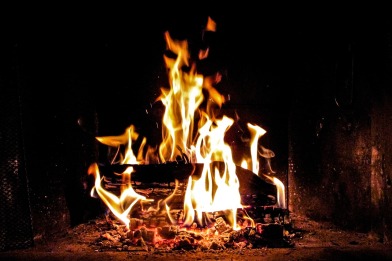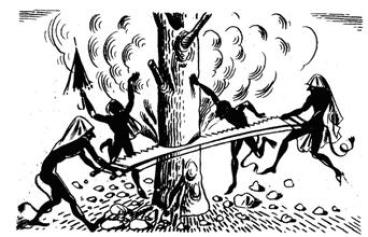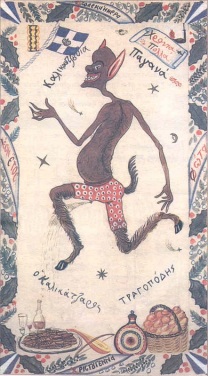Happy holidays, everyone! December’s darkness is upon us: the nights lengthen while the days grow stunted and gray, the air is so cold that it hurts, and the lines at every store are long enough to make you ready to sell your soul just to reach the cashier. Regardless of what traditions you do (or do not) practice, you’ve got to admit that there is something both magical and frightening about this time of year.
As the northern hemisphere prepares to enter into the long winter, all the old traditions of families banding together for survival come blazing back to life. But, as we all know, even the most dire circumstances cannot entire drive away intra-family squabbles. This year, in the spirit of the season, I’d like to put all those annoyances in perspective.

Gather around, everyone.
Let’s talk about the Kallikantzaroi, Greek goblins who will make you yearn for Aunt Purse-Gin and Uncle B.O.. Unlucky witnesses often describe them as short creatures: half-man, half-devil, and mean-looking, with long tails and an abundance of black body hair. They are mostly blind, speak with a lisp, and (outside of what they steal) eat only worms, snails, and frogs. 353 days of the year, the Kallikantzaroi lurk deep underground, sawing away at the World Tree (that plant that holds the whole earth together) with the intent of bringing it down. But when Christmas comes around, they forget their task and scramble into the world of mortals.

Kallikantzaroi going to town on the World Tree, courtesy of Wikimedia Commons.
Slipping between carolers and strings of colorful lights, the Kallikantzaroi dart through the night and try to ferret into your home through whatever opening they can–doors, windows, chimneys, cracks in the walls and floors. Once inside, they drink all your liquor, eat all your food, break everything breakable, piss in your flowerbeds, and generally make your life miserable. Think of your worst possible houseguest, and then times that by a magnitude of 12: the Kallikantzaroi go all in on their destruction, and will keep at it night after night until the 12 days of Christmas (December 25th through the Epiphany on January 6th) are over.
Then, at last, after the the sun starts to shift and the days grow longer and the priest comes by to bless your home, the Kallikantzaroi scurry back under the earth. There, grumbling and bickering, they’ll resume their quest to cut down the World Tree, only to find that in their absence, the trunk has healed. They’ll have to start all over, only to be thwarted again at the last moment next year, when the call of the winter-wrapped mortal world comes anew.

Charming portrait of this month’s subject courtesy of Wikimedia Commons.
While not actively evil (at least, according to some), the Kallikantzaroi are frightening and irritating enough that it’s worth a little effort to avoid them. The simplest method is to burn a Yule log–traditionally one of prickly pear or wild cherry–heartily in the fireplace for the entire holiday, so that nothing can come down the chimney. You can even throw a little salt on the fire so that the crackling and popping will scare them away. You can also hang up a pig jaw, paint a black cross on your door, or set a colander on your doorstep (this latter item will trip the Kallikantzaroi up, as they cannot count past 2 [since 3 is a holy number] and will stay up until dawn trying and failing to count the holes in the bowl). None of these are as fun as my favorite method, though, which is to take the oldest, foulest shoe you can find, and burn it in the fireplace. The smell will drive any Kallikantzaroi far away, with the added benefit of driving everyone else–landlords, bill collectors, loud neighbors, irritating family members–far away, as well.
Where did the Kallikantzaroi come from? Greece is not the only place with a legend like this one, and there are a number of tales about how the creatures came to be. One interesting origin story is that children born during the holidays have morphed into the monsters because their birthdays threatened to upstage Christ. (Pro tip: to avoid your December child becoming a Kallikantzaros, bind them in garlic cloves.) More prosaically, the masked revelers in the ancient Roman Bacchanalia festival might have had drunken shenanigans so legendary that they scarred generations. Your grandmother’s grandmother’s grandmother might have told stories of the Kallikantzaroi simply as a way to illustrate how annoying drunkards can be and advise on ways to keep them at bay (are you picturing a drunk person trying to count the holes in a colander yet? Now you are.).
Any way you cut it, the prospect of a goblin visitor makes the holiday season a little more colorful. Though the Kallikantzaroi were more of a real concern before the dawn of electric lights, some people in Greece (at least according to the Internet) still carry out the traditions of protecting against them. I might too, this year, just to be safe. I’ve got a few old shoes I need to get rid of, anyway.
What is your worst holiday guest experience? How do you think “Kallikantzaroi” is pronounced? Share your story in the comments below.
Featured image by Faizan.





0 Comments